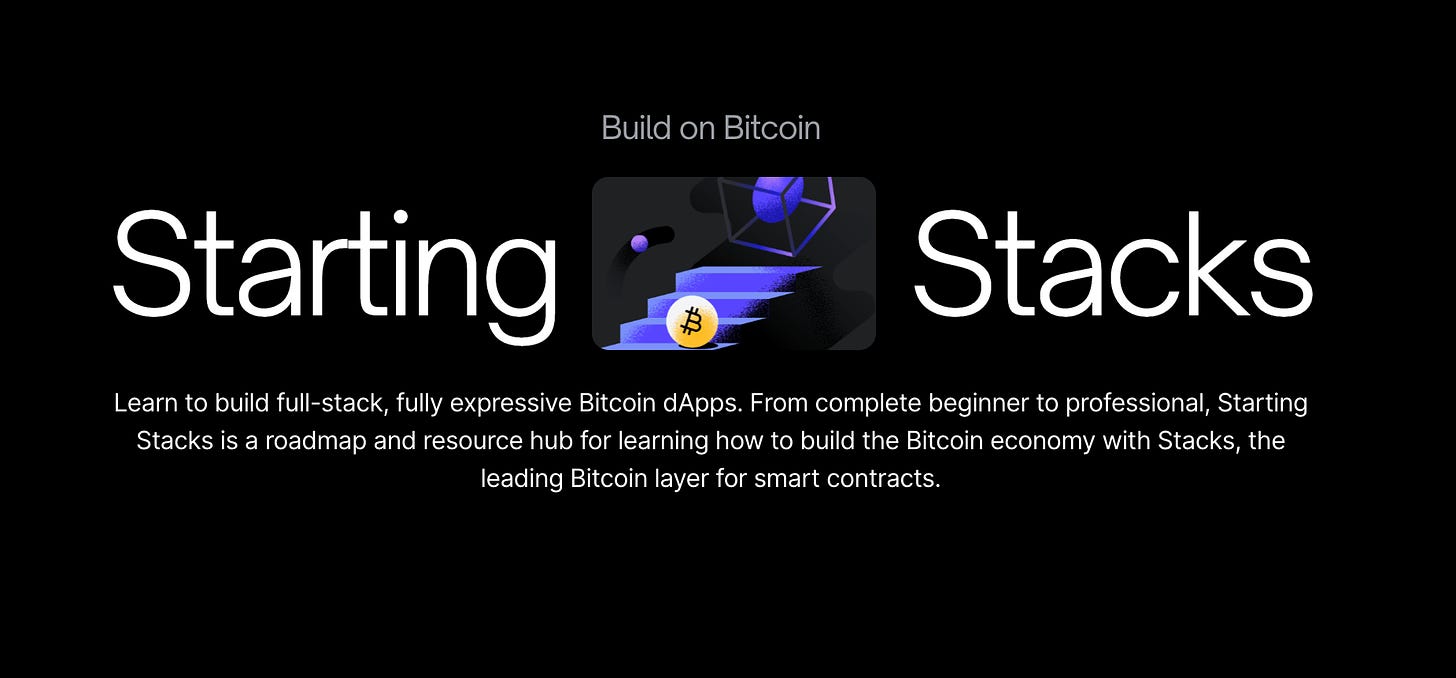The Four Pillars of Blockchain Ecosystem Growth
How to grow an ecosystem, using Stacks as an example
Distribution is critical to the success of a blockchain ecosystem.
As Peter Thiel says,
No matter how strong your product — even if it easily fits into already established habits and anybody who tries it likes it immediately — you must still support it with a strong distribution plan.
But similar to web2 distribution, growth in blockchain ecosystems requires a multifaceted approach.
Here are four critical areas needed to build a strong distribution plan in crypto:
Foundations for Growth
Community and Programs
Strategic Partnerships
Incentive-Driven Growth
Combined, these four pillars provide a holistic strategy to build a strong ecosystem. And similar to web2, there is never a “silver bullet” to growth. An ecosystem must be willing to experiment to discover what works best for its users.
Stacks is a Bitcoin layer that enables decentralized apps and smart contracts. It’s a dynamic ecosystem, and I’ll use Stacks to illustrate these four areas of blockchain ecosystem growth.
Let’s dive in.
1. Foundations for Growth: Developer Resources and Education
At its foundation, an ecosystem must have self-serve resources so any builder — beginner to professional — can start participating in the ecosystem, without permission.
Without strong foundational documentation, the ecosystem risks losing interested participants who are eager to start.
For example, Stacks created Stacks Docs, an extensive knowledge base for developers designed to support and guide developers at all stages of their development journey.
Going further than documentation, Stacks created Starting Stacks, a developer roadmap and resource hub to get started building on Stacks. This serves as a centralized resource for exploring Stacks.
2. Community and Programs
After establishing a solid foundation, the ecosystem must take the next step and foster community engagement. Without a strong community, an ecosystem cannot build a movement.
Community Platforms
Online platforms are a baseline for fostering community growth and inclusiveness.
Platforms like Discord and Telegram are used for real-time discussions, allowing community members to interact with each other and the ecosystem team. This fosters a sense of belonging and provides a direct line of communication.
For example, Stacks maintains an active Discord channel, ensuring the team and builders in the ecosystem can connect and ask questions.
Programs
High-touch events are essential for ecosystem growth. If developer tools and documentation are the base for ecosystem growth, programs create the opportunity to capture the imagination of the ecosystem.
Programs come in all shapes and sizes — from online events to conferences to accelerators.
Online Events:
Online events are a low-cost, high-impact way to reach many people.
Online challenges, games, and competitions can introduce people to the ecosystem and help them to meet others. For example, Stacks partnered with EasyA to run #60DaysofStacks.
In-Person Events and Conferences:
Online is great, but in-person connection cannot be beaten. Ecosystems must ensure they have a presence at the biggest conferences, like Stacks’ participation at Bitcoin Unleashed.
Accelerator Programs, Incubators, and Hackathons:
In addition to online events and conferences, ecosystems can offer additional support through high-touch programming like Accelerator Programs, Incubators, and Hackathons.
For example, Stacks supports ecosystem growth by partnering with programs like the Bitcoin Frontier Fund.
3. Strategic Partnerships
Strategic partnerships, ranging from collaborations with other blockchain projects, integration with popular platforms, and alliances with companies in different sectors, are critical for an ecosystem’s growth strategy.
Often strategic partnerships are technical and require significant planning and building.
For example, Stacks integrated with D’CENT Wallet, a popular South Korean wallet. This type of integration allows D’CENT users to easily start Stacking, which supports STX ecosystem growth.
4. Incentives-Driven Growth
Monetary incentives increase the upside of building on the network. These incentives can range from token incentive models to bounties to build in the ecosystem.
For example, Stacking in the Stacks blockchain involves locking up STX tokens for a set period to support network security and consensus, in return for earning rewards in Bitcoin. This offers a unique incentive mechanism that encourages long-term holding and contributes to the stability and security of the network.
In addition, grants and bounties are a way to grow the ecosystem as they provide a monetary reward for building in the ecosystem.
How To Grow An Ecosystem:
Growing a blockchain ecosystem is complex and dynamic. Often, the strategies are hard to quantify and require winning the hearts and minds of people within the space.
A strategic blend of foundational documentation, community engagement, strategic partnerships, and monetary incentives can work together to create a robust and growing ecosystem.
These strategies do not work in a vacuum and there is never a silver bullet in ecosystem growth.
However, if executed properly, these strategies can align to grow an ecosystem, build a movement, and solve the distribution problem.











